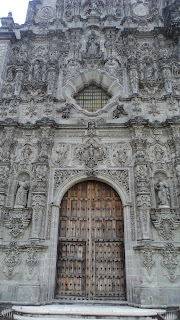The National Museum of the Viceroy Period of Mexico (Museo Nacional del Virreinato) in Tepotzotlan, has open up an exhibit on the life and work of the XVIII century Mexican Painter and Artist, Miguel Cabrera, and his working relationship with the Jesuits. The title of the Exhibit is Miguel Cabrera and The Episodes of Creation (Miguel Cabrera y las Tramas de la Creación).
Maria de los Angeles (far left) received us
on our last visit at the Old Library
of the Museo Nacional del Virreinato.
Emilio Quesada, head of the Jesuit's Iberoamericana
Art Faculty in Mexico City, gave us a lecture in 2104, in situ,
on how Miguel Cabrera composed the golden retablos
for the 3 main altars of the Church in Tepotzotlan
The collection is divided into 5 sections. The first section is an introduction to 18th Century Painting in Nueva España (as Mexico was called during the colonial period). Here we will see where Cristobal del Villalpando left off at the end of the 17th century, and how other painters participated in this golden age of Mexican Arte Sacra. Besides Miguel Cabrera and Cristobal del Villalpando, we will see:
- Juan Correa,
- Nicolas Rodríguez Juárez,
- José de Ibarra,
- Francisco Antonio Vallejo,
- Juan Patricio Morlete Ruiz,
- José de Alzíbar y
- José de Páez
Façade of the Church of Saint Francis Xavier of the Jesuits
Museo Nacional del Virreinato, Tepotzotlan
The second unit or section of the exhibit portrays the Jesuits in the Province of La Nueva España during the first half of the 18th Century. One of the interesting points of is how several of these artist tackle the challenge of painting the ayate of Our Lady of Guadalupe, something equivalent to the mystique of Mexican Catholicism as their Holy of Holies.
A retablo from the side altar
of the Church of Santa Rosa
de Viterbo, Queretaro.
Cabrera painted the Virgin
as well as designing the retablo.
The third unit or section is Tepotzotlan, the Total Creation, where we will witness how Miguel Cabrera creates the entire artistic complex of the Church of Saint Francis Xavier in Tepotzotlan, inside and out.
The fourth unit of the exhibit deals with Miguel Cabrera's involvement with the Congregation of the Most Pure Conception of the Blessed Virgin. We will see how the painter's personal spirituality, faith and devotion was the motor behind his artistic life.
The fifth and final unit of the exhibit shows us "Devotions and Illustrious Men", specially focused on the life of Saint Ignatius of Loyola and other outstanding Jesuits. This unit ties together Cabrera's work here in Tepotzotlan, with what he was doing in Querétaro and in the Jesuit's Novitiate Church in downtown Mexico City, La Profesa, named profesa because that was where the young novices of the Jesuits would "profess" their three public vows: poverty, chastity and obedience, as well as their private vow of obedience to the Pope.a vow that they would have to put to the test when King Carlos III of Spain coerced the Pope into signing an edict by which the Jesuits were effectively exiled not only from Mexico in 1767, but from all of Latin America and from almost all countries in Europe.
If you are interested in coming along with us, please call us at Mexico City number 55 2452 5050 for your reservation, Monday to Friday, 9:00 to 13:00, and 15:00 to 17:45.





No comments:
Post a Comment